 |
 |
 |
| |
New Gas-Powered T20 Injection Device: 48 week study
|
| |
| |
Study results find equivalent T20 drug levels, maintenance of viral response, easier to tolerate, less injection site reactions, and suggestion of better adherence.
Reported by Jules Levin
3rd Intl AIDS Society Conference
July 24-27, 2005
Rio de Janeiro, Brazil
"Enfuvirtide (T20) plasma levels and injection site reactions (ISRs) using a novel needle-free gas-powered injection system (Biojector) for subcutaneous administration of T20 in treatment-experienced HIV+ patients"
authors: JSG Montaner1, R Joy1, G Larsen1,
M Valyi1, E Walker2, M Harris1
1. British Columbia Centre for Excellence in HIV/AIDS, Vancouver, BC.
2. Bioject Inc., Portland, OR
Marianne Harris presented these study results at Rio in an oral presentation.
The fusion inhibitor T20 was shown to be highly effective in the TORO, RESIST, and POWER studies. T20 is administered by twice daily subcutaneous injection
Injection site reactions (ISRs) are the main side effect of T20, occurring at least once over 48 weeks in 98% of patients in the TORO trials.
Harris discussed the Biojector device and presented the results of a study in patients:
It is a needle-free gas-powered injection system.
The potential advantages of Biojector vs. standard needles and syringes:
--Decrease number/severity of ISRs
--Less tissue trauma and local injection pain.
--Easier to use
--More available sites for self-injection
--Less patient teaching time
--Less needle-related anxiety
--Makes T20 an option for patients who refuse to use needles
--Safer; decreased risk of HIV transmission to caregivers
Roche has investigated the use of this device to improve the injection process of T20. Demand for this device appears to be outstripping supply. Roche has applied to regulatory authorities to have the device included into its label or Package Insert, which should improve availability. The B2000 injection system is manufactured by Bioject Medical Technologies. It's a needle-free CO2-powered injector that disperses liquid drug after injecting it through the skin so it appears that nodules may not occur. This device has been available to the public since 1996 to deliver subcutaneous & intramuscular injections for vaccines & other therapies.
Biojector B2000 needle-free
Gas-powered injection system
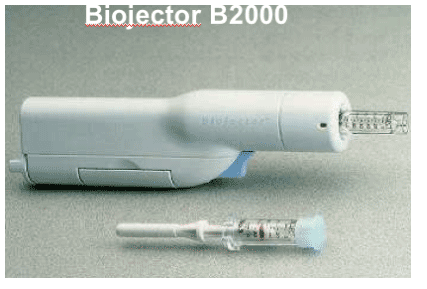
Biojector injection technique
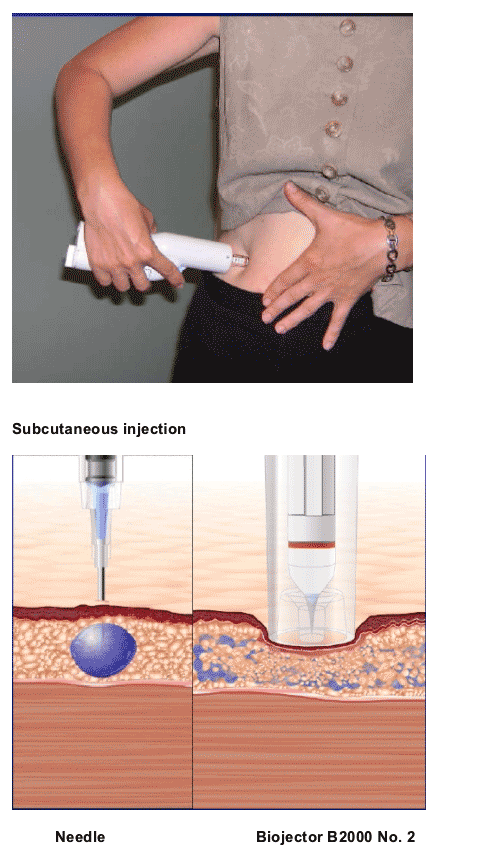
Subcutaneous injection
STUDY OBJECTIVES:
To study T20 administration with the Biojector as compared to standard needles and syringes with regard to:
--T20 plasma levels
--Severity of ISRs
--Ease of administration
AUTHOR CONCLUSIONS (see pictures & tables below of device and study results: pk, patient survey, injection site reactions, viral response)
--Predose trough and 1-hour post-dose T20 plasma levels achieved using the Biojector needle-free injection system are equivalent to those achieved using standard needles and syringes
--Injection Site Reactions (ISRs) are statistically significantly reduced with use of the Biojector.
--The Biojector was easier to use than standard needles, as reported by patient survey
--A few patients prefer to use standard needles.
--After 24 weeks, 63% of patients are using the Biojector for T20 injection and 72% remain on T20.
--6% (2/32) stopped due to Biojector-specific adverse events.
--Longer-term safety and efficacy evaluation of the Biojector for T20 administration is ongoing. (ed note: virologic control appears to remain the same if not improved; see data below).
--The Biojector provides another option for T20 administration.
RESULTS
--33 patients (30 male, 3 female) were instructed in the use of the Biojector
--5 naïve to T20
--4 on treatment interruption from previous T20
--24 currently on T20 for a median of 8 months (range 1 to > 36 months)
--1 did not start
--for the other 32, median 12 weeks follow-up using Biojector (range <1 to 24 weeks)
PATIENT DISPOSITION
--32 started Biojector
--20 still using Biojector
--3 alternating Biojector with needle
--2 lost to follow-up
--10 stopped Biojector
--4 off all ARVs (1 fatigue, 1 hepatotoxicity, 2 VL failure)
--4 stopped <1 week due to pain, swelling, ISR (1 went back on needles, 3 stopped T20)
--2 stopped >4 weeks ( 1 bruising, 1 nerve pain in thigh - both returned to using needles)*
20/32 (63%) using Biojector (3 intermittently)
23/32 (72%) remain on T20
*2/32 (6%) stopped using Biojector due to AEs specific to the device
VIROLOGIC OUTCOMES
--23 have VL available at Biojector baseline and followup
--15 undetectable (or <50 copies/mL) at both baseline and latest available follow-up while using the Biojector
8 detectable (>50 copies/mL) at baseline
--median VL 5855 (range 164 to >100,000)
At latest followup for those 8:
--Median VL 139 (range undetectable to >100,000)
--6 decreased, 3 to undetectable or <50
--2 no change (multidrug resistant HIV)
Nerve Bundle Pain during & after Injection
4 cases in 3 patients - ? related to lack of subcutaneous tissue, location of injection near joints
--1 injected R buttock
Immediate pain in front of thigh
Numbness x >2 weeks
Later similar episode in L leg
--1 injected above L elbow
Immediate pain in forearm
Numbness x 1 month
--1 injected top of L anterior thigh
Immediate pain down to knee lasting several hours
Ongoing numbness, tingling, dysesthesia 3.5 months later
Discontinued using Biojector
T20 levels with Biojector over time
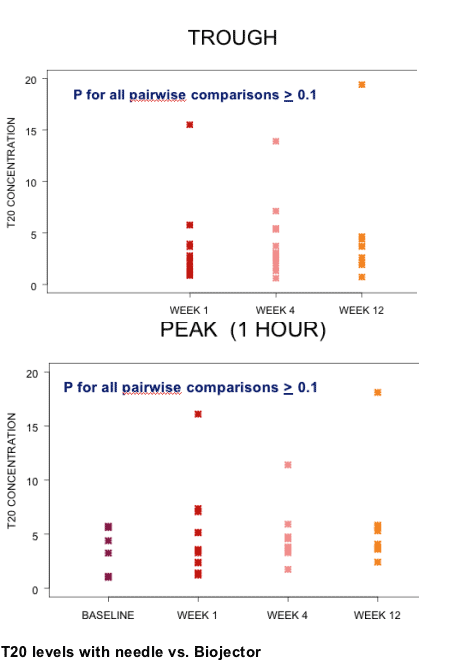
T20 levels with needle vs. Biojector
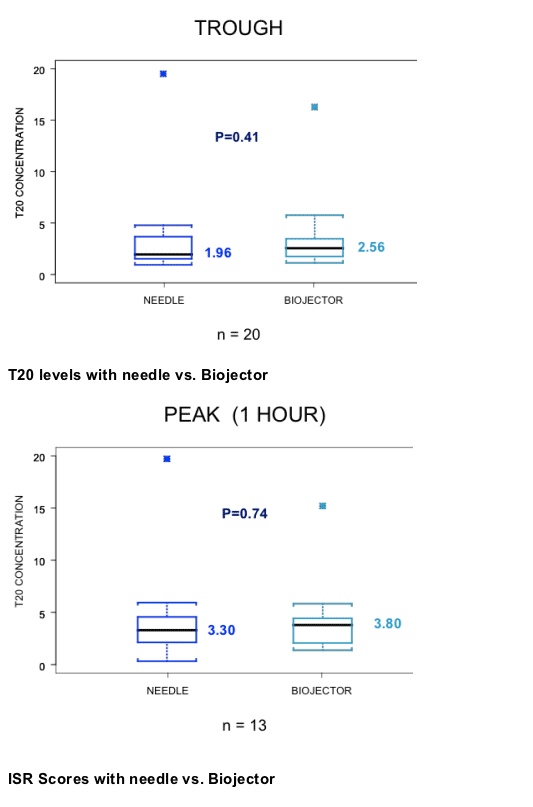
T20 levels with needle vs. Biojector
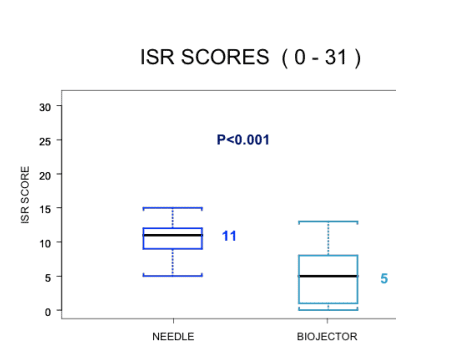
ISR Scores with needle vs. Biojector
INJECTION SITE REACTION (ISR) SCORING SYSTEM
--Grade 0-4 for each parameter (max. total 31)
--Overall grading (subjective pain/discomfort)
--Grading of signs and symptoms (objective)
--Erythema
--Induration
--Pruritus (0-3)
--Nodules and cysts
--Ecchymosis
--Average duration of individual lesions
--Number of individual lesions present
Ease of use scores
Score Description
0 Easy
1 Somewhat easy
2 Somewhat difficult
3 Difficult
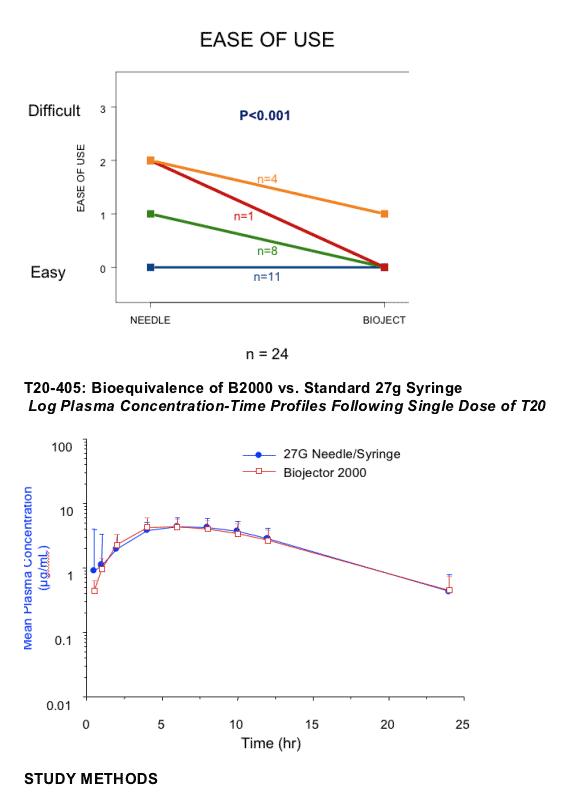
All antiretroviral-experienced HIV+ adults starting or currently receiving needle-based T20 treatment were offered to switch to the Biojector after appropriate training.
Patients enrolled between November 2, 2004 and January 27, 2005.
Patients were assessed 1-2x while using needles, weekly x 4 weeks then every 4 weeks while using the Biojector .
Follow-up to June 30, 2005.
T20 plasma levels
--Plasma was collected pre-dose (11-13 hours after previous dose) and 1 hour post-dose (30-90 minutes) for T20 levels.
--Bioanalysis employed HPLC with tandem mass spectrometry (LC-MS/MS) in a method that is specific for T20 over its known plasma metabolite (T20 deamidated on the C terminus).
--The method for assaying T20 in human plasma has been characterized and shown to be accurate and precise.
--Inter- and intra-assay accuracy and precision better than +/-15% over the calibration range 0.025 to 25.0 µg/mL.
STATISTICAL METHODS
Wilcoxon Signed Rank Tests were used to compare needle-based and Biojector injection systems with regard to:
--T20 plasma levels
--ISR scores
--ease of use scores
|
|
| |
|
 |
 |
|
|